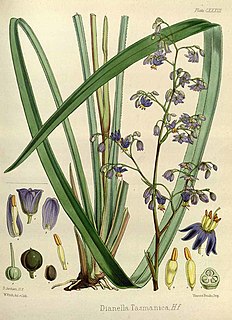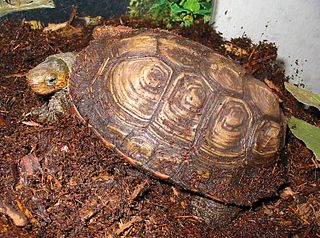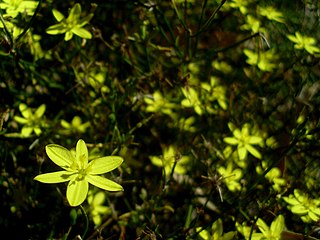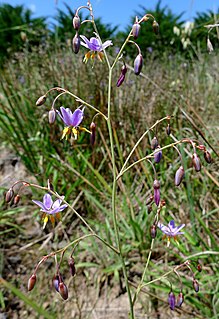
Sagittariidae is a family of raptor with one living species—the secretarybird native to Africa.

Hemerocallidoideae is the a subfamily of flowering plants, part of the family Asphodelaceae sensu lato in the monocot order Asparagales according to the APG system of 2016. Earlier classification systems treated the group as a separate family, the Hemerocallidaceae. The name is derived from the generic name of the type genus, Hemerocallis. The largest genera in the group are Dianella, Hemerocallis (15), and Caesia (11).

Asphodelaceae is a family of flowering plants in the order Asparagales. Such a family has been recognized by most taxonomists, but the circumscription has varied widely. In its current circumscription in the APG IV system, it includes about 40 genera and 900 known species. The type genus is Asphodelus.

George Bentham's taxonomic arrangement of Banksia was published in 1870, in Volume 5 of Bentham's Flora Australiensis. A substantial improvement on the previous arrangement, it would stand for over a century. It was eventually replaced by Alex George's 1981 arrangement, published in his classic monograph The genus Banksia L.f. (Proteaceae).

Dianella tasmanica, commonly known as the Tasman flax-lily or Tasmanian flax-lily is a herbaceous strappy perennial herb of the family Asphodelaceae, subfamily Hemerocallidoideae, found in southeastern Australia including Tasmania. It has leaves to 80 cm, and a flower stem to 1.5 m. Blue flowers in spring and summer are followed by violet berries. It adapts readily to cultivation and is commonly seen in Australian gardens. Unlike other Dianella species, its fruit is toxic.

Rhinoclemmys is a genus of turtles in the family Geoemydidae, the only genus in the subfamily Rhinoclemmydinae. Member species of the genus are commonly known as the Neotropical wood turtles and are the only geoemydids known from the Americas. As such, they have adapted to a wide range of habitats, which is reflected in the species' common names.

Sacalia is a genus of turtles in the family Geoemydidae. The genus was erected by John Edward Gray in 1870. The Sacalia is native to Southereastern China, Laos, and Vietnam. It was declared an endangered species of turtle by the IUCN Red List due to its illegal trade. The sacalia has a carapace of dark-brown color that permits it to camouflage to its habitat. They are believed to select the area of a river that better matches their color.

Stypandra is a small genus of rhizomatous perennials in the family Asphodelaceae, subfamily Hemerocallidoideae. They are native to Australia and New Caledonia.

Chamaescilla is a genus of Australian herbs in the subfamily Hemerocallidoideae within the asphodel family. They have grass-like basal leaves and tuberous roots. The flowers have six petals and six stamens. The seed capsules contain black, glossy seeds.

Tricoryne is a genus of perennial herbs in the family Asphodelaceae, subfamily Hemerocallidoideae. All species are native to Australia with two species extending to New Guinea; within Australia they occur in all 6 states and the Northern Territory.
- Tricoryne ancepsR.Br. - New Guinea, Queensland
- Tricoryne corynothecoidesKeighery - Western Australia
- Tricoryne elatiorR.Br. - Yellow Rush-lily - all 6 states plus Northern Territory
- Tricoryne humilisEndl. - Western Australia
- Tricoryne muricataBaker - Queensland
- Tricoryne platypteraRchb.f - New Guinea, Queensland
- Tricoryne simplexR.Br. - New South Wales
- Tricoryne tenellaR.Br. - Mallee Rush-lily - Western Australia, South Australia

Caesia is a genus of herbs in the family Asphodelaceae, subfamily Hemerocallidoideae, native to Australia, New Guinea, Madagascar and Southern Africa. The mostly 3-lobed seed capsules contain rounded black seeds. The genus was named in honour of Federico Cesi (1585-1630), an Italian scientist.
- Caesia alpina Hook.f. - alpine grass-lily - New South Wales, Tasmania, Victoria
- Caesia calliantha R.J.F.Hend. - blue grass-lily - New South Wales, Tasmania, Victoria, South Australia
- Caesia capensis(Bolus) Oberm. - Cape Province of South Africa
- Caesia chlorantha F.Muell. - New South Wales, Queensland, Western Australia
- Caesia micrantha Lindl. - New South Wales, Tasmania, Victoria, South Australia, Western Australia, Queensland
- Caesia occidentalis R.Br. - Western Australia
- Caesia parviflora R.Br. - pale grass-lily - Queensland, New South Wales, Tasmania, Victoria, South Australia, Western Australia
- †Caesia rigidifolia F.Muell. - Queen Victoria Springs in Western Australia but extinct. Last recorded near Zanthus in 1875.
- Caesia sabulosaBoatwr. & J.C.Manning - Cape Province
- Caesia setifera Baker - Queensland, Western Australia, Northern Territory, New Guinea
- Caesia subulataBaker - Madagascar
- Caesia viscida Keighery - Western Australia

Thelionema is a small genus of tufted perennials in the family Asphodelaceae, subfamily Hemerocallidoideae. All three species, which were previously placed in the genus Stypandra, are native to Australia. These are:

Franklandia is a genus of small shrubs in family Proteaceae, commonly known as lanolin bushes. It is endemic to Southwest Australia.

Raphitomidae is a family of small to medium-sized sea snails, marine gastropod mollusks in the superfamily Conoidea.

Agrostocrinum is a genus of herbs in the family Asphodelaceae, subfamily Hemerocallidoideae, first described by Ferdinand von Mueller as a genus in 1860. The entire genus is endemic to the State of Western Australia.
- Agrostocrinum hirsutum(Lindl.) Keighery, Nuytsia 15: 250 (2004)
- Agrostocrinum scabrum(R.Br.) Baill., Bull. Mens. Soc. Linn. Paris 2: 1119 (1893)

Corynotheca is a genus of herbs in the family Asphodelaceae, subfamily Hemerocallidoideae, first described as a genus in 1878. The entire genus is endemic to Australia.
- Corynotheca asperataR.J.F.Hend - Western Australia, Northern Territory
- Corynotheca flexuosissimaR.J.F.Hend. - Western Australia
- Corynotheca lateriflora(R.Br.) F.Muell. ex Benth. - Northern Territory
- Corynotheca licrotaR.J.F.Hend. - Northern Territory, Queensland, New South Wales, Victoria, South Australia
- Corynotheca micrantha(Lindl.) Druce - Northern Territory, Queensland, Western Australia, South Australia
- Corynotheca pungensR.J.F.Hend. - Western Australia
Hensmania is a genus of herbs in the family Asphodelaceae, first described as a genus in 1903. The entire genus is endemic to the State of Western Australia.
- Hensmania chapmaniiKeighery, Fl. Australia 45: 486 (1987)
- Hensmania stoniellaKeighery, Fl. Australia 45: 486 (1987)
- Hensmania turbinata(Endl.) W.Fitzg., Proc. Linn. Soc. New South Wales 28: 106 (1903)

Pasithea is a genus of herbs in the family Asphodelaceae, subfamily Hemerocallidoideae, first described as a genus in 1832. It contains only one known species, Pasithea caerulea, native to Peru and Chile in South America.

Dianella amoena, commonly known as the matted flax-lily, is an endangered, herbaceous, perennial plant endemic to Australia. It belongs to the family Asphodelaceae, subfamily Hemerocallidoideae. It has long grey-green leaves which grow in clumps from an underground rhizome, and displays blue-purple flowers in spring-summer, up to 90cm in height. The common name Matted Flax-lily refers to its extensively rhizomatous nature, sometimes forming large mats up to 5m wide.

















